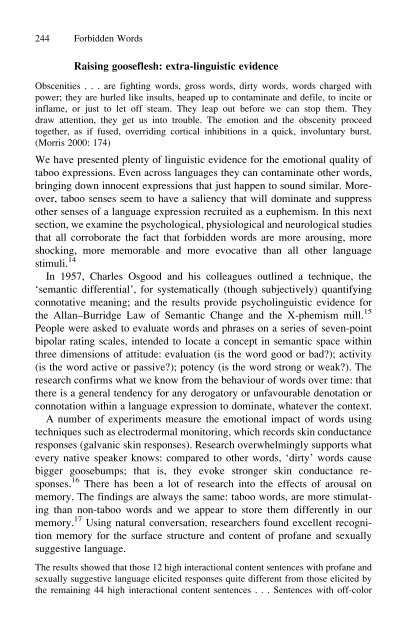Forbidden Words: Taboo and the Censoring of Language
Forbidden Words: Taboo and the Censoring of Language
Forbidden Words: Taboo and the Censoring of Language
Create successful ePaper yourself
Turn your PDF publications into a flip-book with our unique Google optimized e-Paper software.
244 <strong>Forbidden</strong> <strong>Words</strong><br />
Raising gooseflesh: extra-linguistic evidence<br />
Obscenities . . . are fighting words, gross words, dirty words, words charged with<br />
power; <strong>the</strong>y are hurled like insults, heaped up to contaminate <strong>and</strong> defile, to incite or<br />
inflame, or just to let <strong>of</strong>f steam. They leap out before we can stop <strong>the</strong>m. They<br />
draw attention, <strong>the</strong>y get us into trouble. The emotion <strong>and</strong> <strong>the</strong> obscenity proceed<br />
toge<strong>the</strong>r, as if fused, overriding cortical inhibitions in a quick, involuntary burst.<br />
(Morris 2000: 174)<br />
We have presented plenty <strong>of</strong> linguistic evidence for <strong>the</strong> emotional quality <strong>of</strong><br />
taboo expressions. Even across languages <strong>the</strong>y can contaminate o<strong>the</strong>r words,<br />
bringing down innocent expressions that just happen to sound similar. Moreover,<br />
taboo senses seem to have a saliency that will dominate <strong>and</strong> suppress<br />
o<strong>the</strong>r senses <strong>of</strong> a language expression recruited as a euphemism. In this next<br />
section, we examine <strong>the</strong> psychological, physiological <strong>and</strong> neurological studies<br />
that all corroborate <strong>the</strong> fact that forbidden words are more arousing, more<br />
shocking, more memorable <strong>and</strong> more evocative than all o<strong>the</strong>r language<br />
stimuli. 14<br />
In 1957, Charles Osgood <strong>and</strong> his colleagues outlined a technique, <strong>the</strong><br />
‘semantic differential’, for systematically (though subjectively) quantifying<br />
connotative meaning; <strong>and</strong> <strong>the</strong> results provide psycholinguistic evidence for<br />
<strong>the</strong> Allan–Burridge Law <strong>of</strong> Semantic Change <strong>and</strong> <strong>the</strong> X-phemism mill. 15<br />
People were asked to evaluate words <strong>and</strong> phrases on a series <strong>of</strong> seven-point<br />
bipolar rating scales, intended to locate a concept in semantic space within<br />
three dimensions <strong>of</strong> attitude: evaluation (is <strong>the</strong> word good or bad?); activity<br />
(is <strong>the</strong> word active or passive?); potency (is <strong>the</strong> word strong or weak?). The<br />
research confirms what we know from <strong>the</strong> behaviour <strong>of</strong> words over time: that<br />
<strong>the</strong>re is a general tendency for any derogatory or unfavourable denotation or<br />
connotation within a language expression to dominate, whatever <strong>the</strong> context.<br />
A number <strong>of</strong> experiments measure <strong>the</strong> emotional impact <strong>of</strong> words using<br />
techniques such as electrodermal monitoring, which records skin conductance<br />
responses (galvanic skin responses). Research overwhelmingly supports what<br />
every native speaker knows: compared to o<strong>the</strong>r words, ‘dirty’ words cause<br />
bigger goosebumps; that is, <strong>the</strong>y evoke stronger skin conductance responses.<br />
16 There has been a lot <strong>of</strong> research into <strong>the</strong> effects <strong>of</strong> arousal on<br />
memory. The findings are always <strong>the</strong> same: taboo words, are more stimulating<br />
than non-taboo words <strong>and</strong> we appear to store <strong>the</strong>m differently in our<br />
memory. 17 Using natural conversation, researchers found excellent recognition<br />
memory for <strong>the</strong> surface structure <strong>and</strong> content <strong>of</strong> pr<strong>of</strong>ane <strong>and</strong> sexually<br />
suggestive language.<br />
The results showed that those 12 high interactional content sentences with pr<strong>of</strong>ane <strong>and</strong><br />
sexually suggestive language elicited responses quite different from those elicited by<br />
<strong>the</strong> remaining 44 high interactional content sentences . . . Sentences with <strong>of</strong>f-color

















